 Tying in nicely with Skype’s new video calling feature (Skype 2.0, now in public beta), Creative have announced a new WebCam certified by Skype.
Tying in nicely with Skype’s new video calling feature (Skype 2.0, now in public beta), Creative have announced a new WebCam certified by Skype.
Regaling under the moniker of the Creative WebCam Instant Skype Edition, the package comes with a personal headset with microphone, software, and a stand-alone microphone if several people want to join in with the chat.
Bundled in the box is a free voucher for up to 30 minutes of SkypeOut, no doubt to tempt buyers to keep on buying time on Skype’s PC-to-landline or mobile phone calling service.
“Skype seeks to revolutionise the way everyone communicates using the Internet via chat, voice and now with video by making it simple. Creative shares that vision,” said James Bilefield, vice president of business development for Skype.
 “Our partnership with Creative is important in helping to make the consumer experience with Skype Video calling simple and effective,” he continued.
“Our partnership with Creative is important in helping to make the consumer experience with Skype Video calling simple and effective,” he continued.
Jean-Marc Dupuis, Joint-General Manager of Creative Labs Europe felt that the simplicity of Skype’s new service would generate huge interest in video calling, adding, “Making phone calls over the Internet is the new wave in communications.”
Webcam sales have been soaring in recent years, with European sales growing by over 139 percent in the past two years.
The new Skype-certified WebCam looks much the same as any other webcam (let’s face it, they’re never much to look at) and features an advanced CMOS sensor capable of capturing video at 352×288 at 30 frames per second.
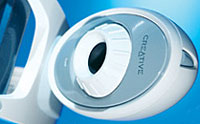 There’s also a ‘snapshot button’ for taking low res stills at 640×480 via interpolation (in other words, it’s a smaller image artificially blown up, so don’t expect anything near digicam quality).
There’s also a ‘snapshot button’ for taking low res stills at 640×480 via interpolation (in other words, it’s a smaller image artificially blown up, so don’t expect anything near digicam quality).
The little fella comes with a plastic stand which can be attached to flat panel and notebook displays and a “comprehensive software bundle” for image editing and management.
TECH STUFF:
Technical Specifications352x288 (CIF) CMOS sensorVideo Capture at up to 352x288USB 1.1 connection
System RequirementsIntel Pentium II or AMD Athlon processor running at 400MHz or higherWindows 2000, or XP128MB RAM100MB free disk space (excluding third party software installation)
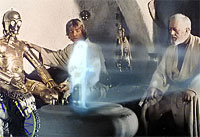 US scientists have created imaging technology that lets viewers enjoy what they claim to be the first truly three-dimensional holographic movies.
US scientists have created imaging technology that lets viewers enjoy what they claim to be the first truly three-dimensional holographic movies. Made by Texas Instruments, these clever puppies are currently used in television, video and movie projectors and incorporate a computer that processes an incoming digital signal several thousand times a second.
Made by Texas Instruments, these clever puppies are currently used in television, video and movie projectors and incorporate a computer that processes an incoming digital signal several thousand times a second. If you look at interferograms on a PC screen, all you get is a series of random black dots creating an effect that looks a bit like a telly on the blink.
If you look at interferograms on a PC screen, all you get is a series of random black dots creating an effect that looks a bit like a telly on the blink.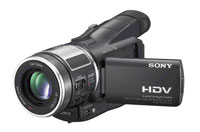 Pausing briefly for breath after announcing the new PlayStation today, the busy bees in the Sony hive have announced the world’s smallest and lightest high definition consumer camcorder with full HD resolution based on HDV 1080i.
Pausing briefly for breath after announcing the new PlayStation today, the busy bees in the Sony hive have announced the world’s smallest and lightest high definition consumer camcorder with full HD resolution based on HDV 1080i. The new camera also uses a smaller and more compact Carl Zeiss lens, with a diameter of 60mm compared to 92 mm on the previous model.
The new camera also uses a smaller and more compact Carl Zeiss lens, with a diameter of 60mm compared to 92 mm on the previous model. A Memory Stick PRO Duo media slot is provided for transferring images captured on the camcorder’s 2.8-megapixel still camera.
A Memory Stick PRO Duo media slot is provided for transferring images captured on the camcorder’s 2.8-megapixel still camera. “The new IMAGEON processors from ATI combine advanced audio and video processing capabilities to turn mobile phones into mobile entertainment centers.”
“The new IMAGEON processors from ATI combine advanced audio and video processing capabilities to turn mobile phones into mobile entertainment centers.”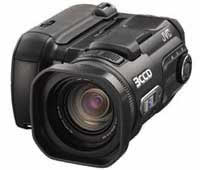 The diminutive JVC GZ-MC500 comes with three 1/4.5-inch CCD that records high-quality MPEG-2 video onto CompactFlash microdrives, with a 4 gig card, capable of storing up to an hour of “DVD-quality” video.
The diminutive JVC GZ-MC500 comes with three 1/4.5-inch CCD that records high-quality MPEG-2 video onto CompactFlash microdrives, with a 4 gig card, capable of storing up to an hour of “DVD-quality” video.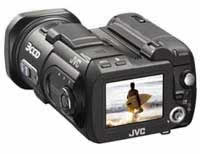 Translated into a language approaching English, this means that the camera is able to produce thumping great 5-megapixel with a resolution of 2560 x 1920 pixels still shots. This is second only to Samsung’s latest Duocam camcorder.
Translated into a language approaching English, this means that the camera is able to produce thumping great 5-megapixel with a resolution of 2560 x 1920 pixels still shots. This is second only to Samsung’s latest Duocam camcorder.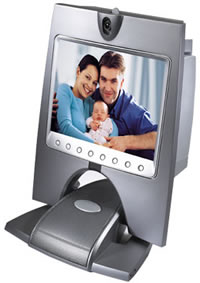 Every few years there are a number of announcements about the launch of new video phones. For decades the public have been told that this revolution is just around the corner.
Every few years there are a number of announcements about the launch of new video phones. For decades the public have been told that this revolution is just around the corner. Designed for law enforcement, perimeter security and long-range video links,
Designed for law enforcement, perimeter security and long-range video links,  We’ve been keeping our eye on Akimbo, an IP-delivered VOD (Video-On-Demand) service and have learnt that they are launching and have signed on Amazon.com as its official retailer. Akimbo has just launched its video-on-demand service and signed on Amazon.com as its official retailer. Akimbo is to video what Apple’s iTunes is to the iPod. The Akimbo Player, utilising an easy “Queue and View” format is a set-top box that delivers hundreds of mainly niche program videos to television through a broadband-Internet connection allowing consumers to choose content and view it on-demand – or maybe even later.
We’ve been keeping our eye on Akimbo, an IP-delivered VOD (Video-On-Demand) service and have learnt that they are launching and have signed on Amazon.com as its official retailer. Akimbo has just launched its video-on-demand service and signed on Amazon.com as its official retailer. Akimbo is to video what Apple’s iTunes is to the iPod. The Akimbo Player, utilising an easy “Queue and View” format is a set-top box that delivers hundreds of mainly niche program videos to television through a broadband-Internet connection allowing consumers to choose content and view it on-demand – or maybe even later.